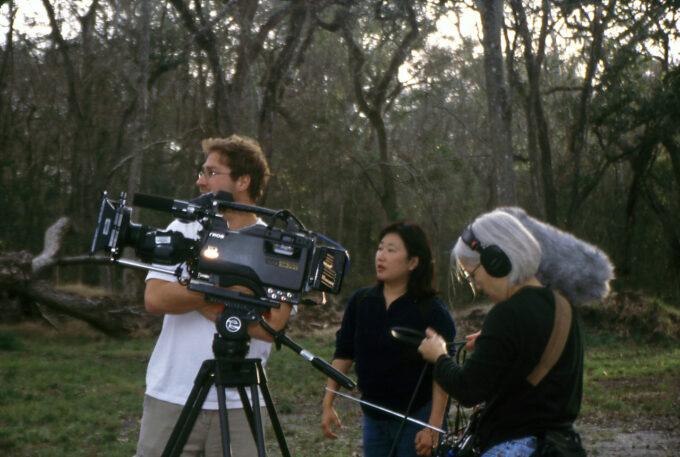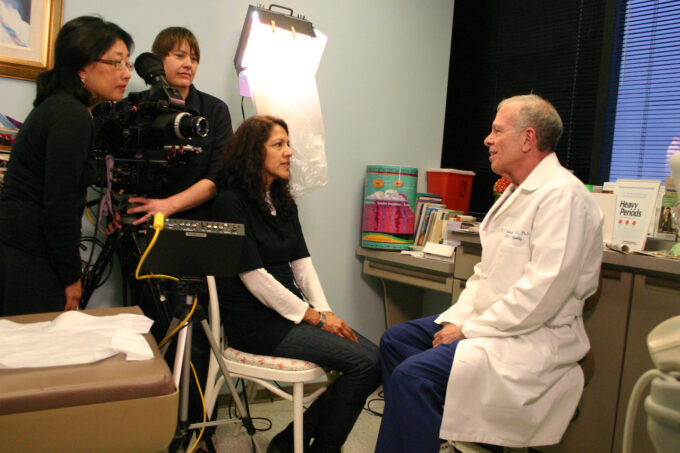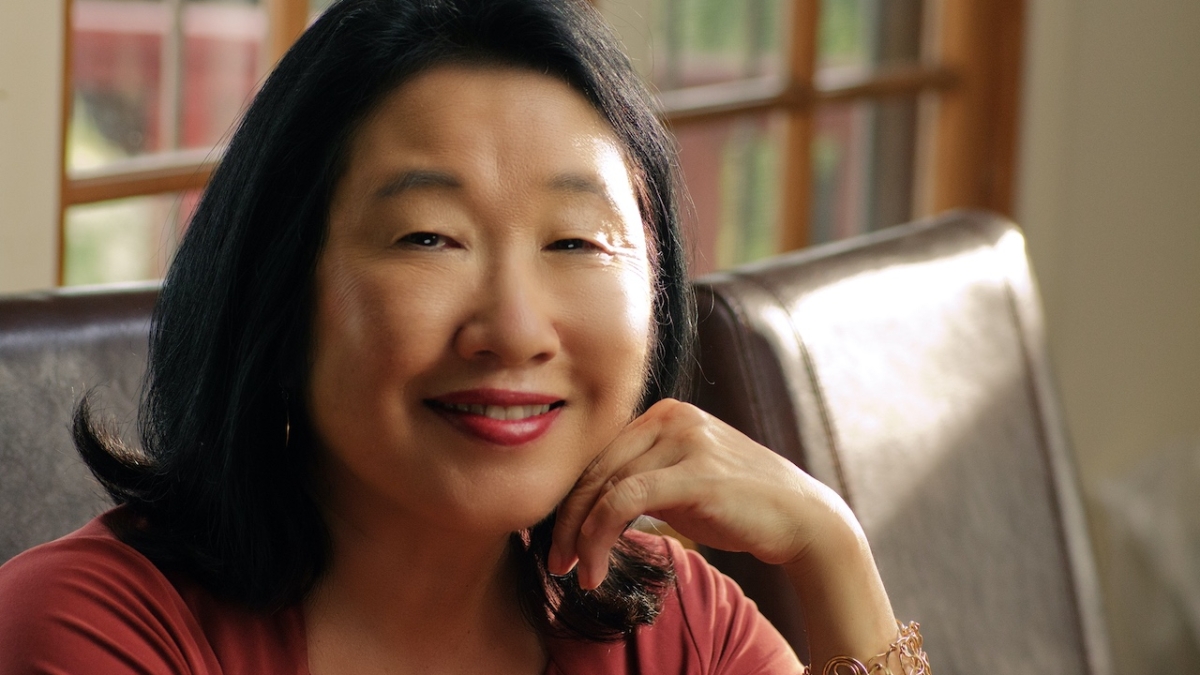Written By: Kano Umezaki
Back in late June of 2021, I had the pleasure of speaking with documentary filmmaker and activist, Renee Tajima-Peña, about the PBS “Asian Americans” series, the origins of the Asian/American political film movement, and the struggles Asian/American and other racialized documentary filmmakers face in the media industry. I have long looked up to her creative work, having heavily leaned on her writings and films for my undergraduate thesis on the shared anti-imperialist origins of Third Cinema and Asian/American film. I was very excited to speak to her about the socially committed legacy of Asian/American film and how to collectively carry this legacy forward in today’s more digitized modern age.
Renee Tajima-Peña is currently a professor of Asian American studies at the University of California Los Angeles (UCLA) where she is the Director of the Center for EthnoCommunications. In addition to her Academy Award-nominated film collaboration with Christine Choy, “Who Killed Vincent Chin?” (1987), she has also directed “My America … Or Honk if you Love Buddha” (1997), “Calavera Highway” (2008), “Skate Manzanar” (2017) and “No Más Bebes” (2015), along with other documentaries about race, immigration, ethnicity, gender and social justice.
More recently, she was senior producer and showrunner of the PBS “Asian Americans” docuseries, a five-part series that explores the extensive history of Asia/America, made in collaboration with a team of Asian/American filmmakers and scholars. She has also created the May 19th project earlier this year alongside Jeff Chang, which explores AAPI’s history of solidarity with other racialized peoples through a docuseries of fourteen two to three-minute videos and numerous social posts.
Committed to the independent Asian/American filmmaking community, she has helped found the Center for Asian American Media (CAAM) and the Asian American Documentary Network (A-Doc), and was also previously first paid staff person at Asian CineVision, where she served as an editor for “Bridge: Asian American Perspectives” (which eventually became this very CineVue!).

Kano Umezaki: In the PBS “Asian Americans” series, you show an interesting dynamic between Asia American resistance versus assimilation and the contradictory blurring of the two. Winifred Chin’s father, Tung Pok Chin, for instance, refused to comply with the Confession Program, but he faked assimilation by putting up Americanized posters around the house and appealing to Western patriots. Considering many Asian Americans are forced to assimilate, or appear assimilated out of survival, how did you come to holistically tell Asian American stories without essentializing them?
Renee Tajima-Peña: I think there’s a big difference between assimilation and survival. When you talk about assimilation versus resistance, those are binaries that we don’t really exist in. We don’t exist in binaries; we exist in the layers. And our lives are very complicated. I never looked at the series as a tension between resistance and assimilation. The kind of overall goal here was to share how we are existing in this time, how in the past years, recent years, increasing diversity, yet we’re also becoming more divided as a nation. So, how does the history of Asian Americans not only illuminate for Asian Americans, but for all Americans, a way forward; and that is through addressing white supremacy and systemic racism.
KU: In 2014, you published a manifesto titled, “Towards a Third Wave: Why Media Matters in Asian American Studies,” where you call on Asian/American artists, scholars, and community members to use hybrid media to “… expand the reach of Asian American studies.” The title of your manifesto makes a clear allusion to Fernando Solanas and Octavio Getino’s 1969 manifesto, “Towards a Third Cinema.” Why did you decide to create this parallel?
RTP: “Towards a Third Cinema” was very intentionally looking at the use of moving images of film as a political project, as an act of resistance. And so I was calling, not for continuing the use of film as an act of resistance, but reminding us of our legacy. I don’t really remember my article too well, but I know the way I’ve been thinking.
If you think of Asian American independent filmmaking, and it goes back to the early 1900s and the days of film pioneers Marion Wong and Sessue Hayakawa, but if you look at the more contemporary wave that began in the 1960s and early 1970s, as part of the Asian American movement, [Asian American film] has always been the collaboration of creatives with scholars and activists. That’s how it started, if you look back.
There were times when that coalition weakened a bit in the 1980s and part of the 1990s, at a time in the Asian American movement when there was also this transition towards professionalism. Nonprofits started to get these structures with boards of directors who were often in the corporate world or professions, not necessarily with the community, in order to sustain themselves with donor funds and grant funds. Filmmakers were trying to get careers, three-picture deals. Scholars, young Asian American scholars, when the field was very new, needed tenure and needed to advance in their careers. So people became a little more silo-ed.
But I think that, at times, like during the resurgence of ant-Asian hate in the ‘80s and after 9/11 when Muslims and South Asians were being targeted at different periods, it’s been so important to come together to create media that can resist attacks on our communities; to tell our stories, to shift our narrative. I talked about this growing narrative of not only anti-Asian hate but using Asian Americans as this anti-Black, anti-Brown wedge, that narrative, this very misleading narrative. So it’s very important for Asian Americans to, as creatives, be a part of presenting an alternative narrative, to shift that narrative, to tell our own stories.

KU: You were one of the co-writers of the funding proposal for the National Asian American Telecommunications Association (NAATA), which eventually became the now-existing Center for Asian American Media (CAAM). I understand funding is very underdeveloped, and perhaps intentionally so, for racialized independent filmmakers. How have funding problems, for you personally, impacted the kinds of stories you’re allowed to tell on-screen?
RTP: Oh it completely impacts it. For the PBS “Asian Americans” series, we had six episodes lined up. And up to the start of production, we intended to produce those six episodes that would’ve taken us to the present day. And we had to drop one; we had to drop episode six because we couldn’t raise the money. I mean that’s ridiculous. Ken Burns got six hours to do one white dude, Ernest Hemingway. Even the American buffalo got four hours. And for 170 years of the Asian American experience, we got five.
And I think that there’s always these assumptions that Asian Americans are a niche story, very specific to a small audience and will not reach larger diverse audiences; and for the gatekeepers, they usually mean white audiences. Then there’s this idea that Asian Americans are model minorities. I faced that throughout my whole career. If I deal with racism, and the Asian American experience, people don’t understand what racism has to do with Asian Americans because we’re seen as this assimilated, quiet model minority.
If you look at the numbers, it’s kind of outrageous. The percentage of philanthropy dollars that go to any Asian American organization or projects; it’s minuscule, especially compared to our population in the United States.
But I’ll say one thing. For decades and decades and decades, we’ve organized. The formation of NAATA, now CAAM, was a part of national organizing. We had chapters and members across the country. People were demanding that Asian Americans have access to a voice in media; that we have a platform and resources for creating our own content. A-Doc, Asian American Documentary Network, was really a response to Asian Americans being so left behind in this golden age of documentary filmmaking in recent years.
And oftentimes, stories of BIPOC people are told by white filmmakers; we aren’t telling our own stories. I mean we are, but the big money, the people with the largest platforms, the biggest budgets, they tend to be white filmmakers. That’s changing now in large part because of advocacy and speaking out and organizing around that. And organizing together. The solidarity of BIPOC documentary filmmakers has been astonishing. It has been really powerful.
KU: With persistent anti-Asian violence, further invigorated by Sinophobia and anti-communism, counter-storytelling works like the PBS “Asian Americans” series is critical. Why do you believe Asian American visibility and voices in media is important for our collective liberation?
RTP: Toni Morrison has said that there’s a master narrative not written by us. And the narrative matters. Christine Choy and I made “Who Killed Vincent Chin” (1987) about the Vincent Chin case. At that time, the narrative of Asian Americans was that Asian Americans have no problems because they’re a model minority. So they weren’t recognized as a legal class in civil rights prosecutions. And that was the central fight for the Justice for Vincent Chin’s campaign: to have people recognize that Asian Americans have been targets of institutionalized racial violence since we came here. So that was the big picture. That narrative matters. And more recently, with the narrative of the Atlanta shootings, where the day after the shootings, the local sheriff had a press briefing and the spokesperson said there was nothing racially motivated about the shooting. He claimed Aaron Long told them that he was having a bad day and he had a sex addiction. But Asian Americans, we knew our truth.
Asian American women scholars and activists turned to the 1875 Page Act which targeted Chinese women and essentially banned them from entering this country because they were seen as prostitutes, as carriers of diseases. I mean isn’t that familiar? And so we can see how those cultural images and those attitudes of Asian women were so persistent over the next four wars fought in Asia, over generations and decades. And we can see how for Aaron Long those kinds of cultural images could be baked in, as it is in the American psyche.
KU: What other projects are you working on at the moment?
RTP: The May 19 Project continues. The Queer Possibilities video has been expanded; we’ve translated all the videos into multiple Asian languages working with Chinese for Affirmative Action, the (formerly) We Chat Project and others; and we’re working on a collaboration with KCET.org. I also plan to make a feature-length documentary that digs deeper into the history of Asian and Black relations.
And for a lot of us on the Asian Americans producing team — Don Young from CAAM, Jean Tsien, and Leo Chiang and Grace Lee who co-founded A-Doc — we see passing it on to the next generation as being central to our filmmaking work. I just read about a group of Philadelphia filmmakers who weren’t satisfied by the breadth of the “Asian Americans” series and so produced their own locally-oriented series. That is very cool. That’s what we hoped for.
Follow Renee Tajima-Peña on Twitter and Instagram to stay up to date on ongoing and future projects.

